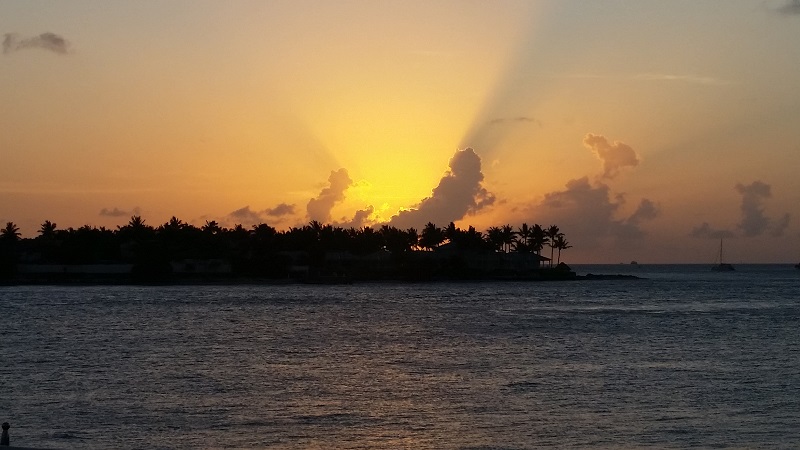We spent a Friday in late June at Dry Tortugas National Park in Florida. Because the park is 70 miles west of Key West, in the middle of the Gulf of Mexico, it is one of the more isolated parks run by the United States. It is also one of the smallest in terms of land mass – most of the 100 square miles of the park consist of the ocean and only seven small islands are above the water. The most visited one is Garden Key, the home of Fort Jefferson. Although we’re going to go into more detail about the trip later in this post as well as tips for first-time visitors planning, I figured I would start with what we loved and why we are going to go back.
First, the fort and island captivated us – we love history. From the inhabitants of the prison to the strategic importance of the islands in the history of commerce, it is an amazing story.
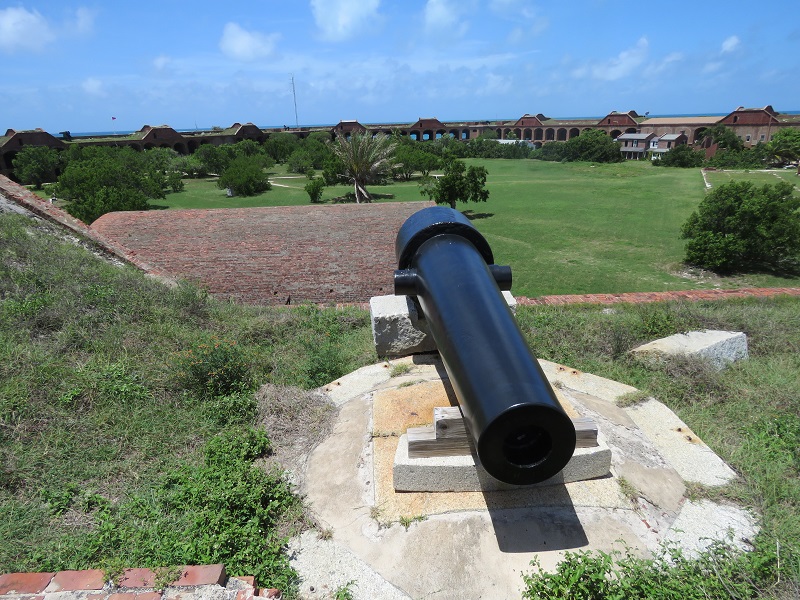
Second, the scenery is beautiful. Both the boat ride and the top level of the fort provides amazing views of the surrounding landscape. We can’t wait to spend the night on the island and get to see both the sunset and the sunrise.
This is a photo from the top of Fort Jefferson of Bush Key, which is off limits during nesting season. So pretty!
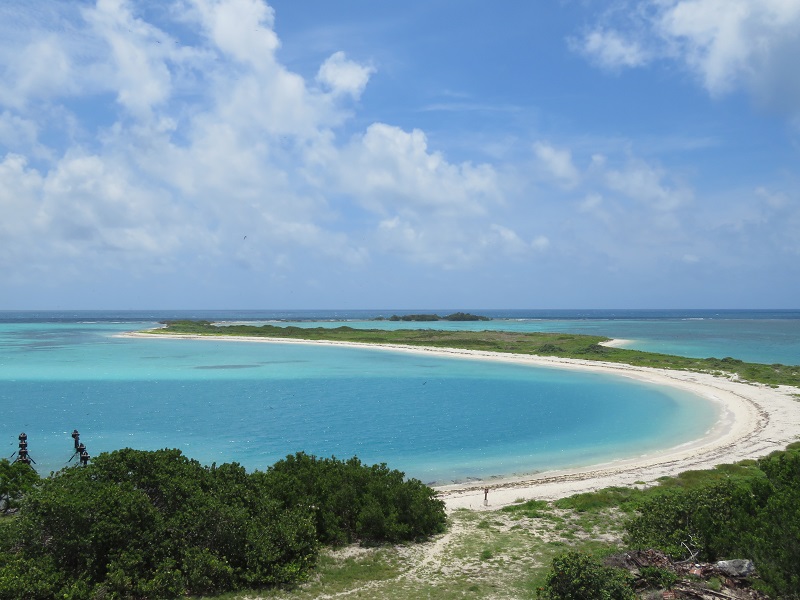
Third, the wildlife is different and intriguing. We were continually amazed by the magnificent frigatebirds soaring overhead and the brown pelicans sitting on posts at the docks. The fish, both those spotted while walking along the moat wall as well as during snorkeling, kept us peering into the crystal clear water for the next gem.
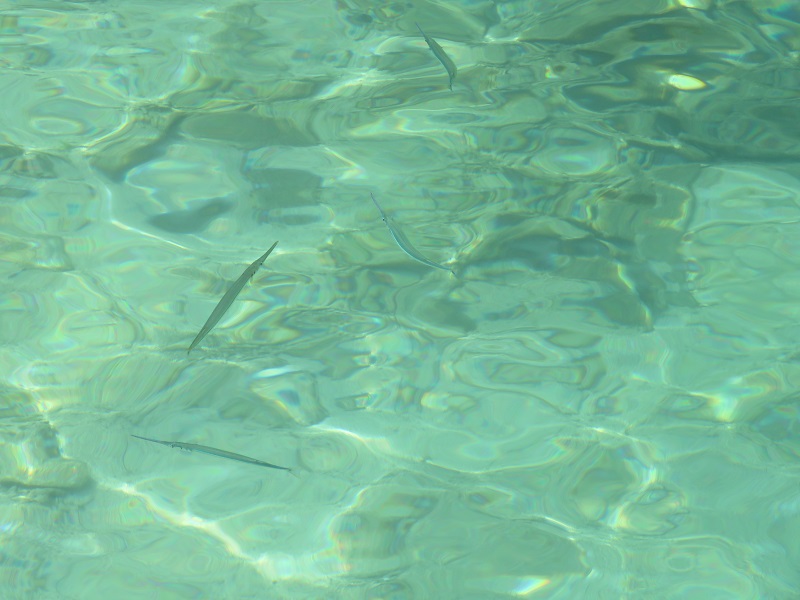
Finally, even though we spent the entire time on the island with a ferry boat of nearly 200 people, we definitely still found plenty of space to be alone. The high walls of the fort are a pretty good barrier – and except for an encounter with the tour group, you rarely found yourself encountering too many other people while exploring the fort. There are three levels to the fort (ground floor, second floor, and roof) and people tend to spread out. The only places that we encountered large groups of people were at the boat/changing areas and the sand of the south beach area. We’re sure that an overnight encounter in the park, without the day visitors, will be amazing.
So that’s what why we’re going back. But here’s a chronicle of our day for those also considering going to the Dry Tortutagas for the first time. We were going to be in Florida on vacation, so we decided to make the drive down to Key West to cross the Dry Tortugas off our life list. We didn’t have time to stay overnight in the park, but we were hopeful that a half day would be enough to explore Garden Key and see the sights. A day trip is indeed just enough time to do everything that you want to do (briefly) and get your feet wet and ready for more.
The Dry Tortugas are reached by either seaplane or boat. The Yankee Freedom III is the cheaper option but takes nearly four times as long. The seaplane is approximately 40 minutes while the boat takes around 2.5 hours. If you own a boat, or want to charter one, that is also an option. We arrived via the Yankee Freedom III. We made the reservations several weeks in advance and both the day before and after were already booked. So if you have a limited window in Key West to make it out to the national park, be sure to book your travel early! If you’re looking to camp, reserve your spot even sooner – Yankee Freedom is the only option that transports your camping gear for you, and they only take over 10 campers a day.
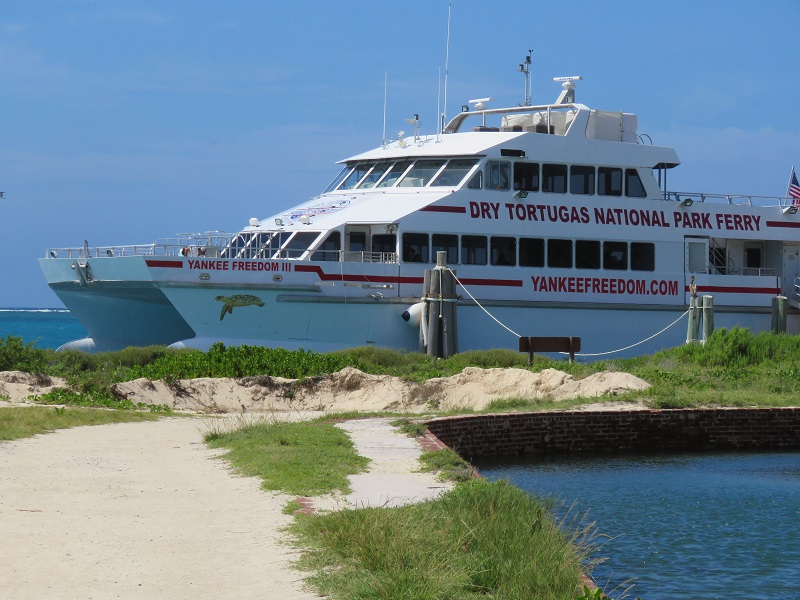
(The above photo of the Yankee Freedom III was taken at the dock on Garden Key in the park)
The boat leaves promptly at 8 AM. They recommend that you arrive between 7 and 7:15 AM. We were running a little late and were one of the last people to check in at 7:30 AM. We parked in the garage immediately across the street from the building and dock. The fee to park there all day was $14. It worked out well as we were able to leave the car parked there after we returned, take the harbor walk down to Duval Street, and explore.
The check in process for the ferry happens on the second floor of the building. We found it quickly and easily. We gave them the name of the reservation and showed them our national park pass to receive a credit of $10 per person back from the ferry. Each ticket includes a $10 entry fee – if you have the annual pass then you do not need to pay it and they return the portion of the money paid for the entry fee from the reservation. They also gave us our boarding passes.
The informational briefing was just starting when we arrived. We received a variety of information during it, such as what to do if you are feeling sea sick (short version – go outside at the back of the boat on the first level where it is most stable and tell a crew member so that they can give you a package of items including a vomit bag), the details of breakfast and lunch service, and operation of the toilets in the bathroom. Boarding started immediately following the end of the briefing in groups of 25 – those people who received the lowest numbered pass during check-in were allowed to board first.
Breakfast was available immediately during boarding so we grabbed two seats in the dining area and waited for the line to shorten a bit. Breakfast is served until 8:30 so you have about thirty minutes to get food. This proved plenty of time for us to eat and make a second trip. There was an assortment of options including cereal, bagels, cream cheese, ham, cut cheeses, fruit and drinks such as milk and orange juice. Coffee and hot water (tea) are available throughout the journey. After breakfast was over, they put out items for sale in the breakfast area. I had already bought a dose of dramamine (motion sickness medication) for $1 immediately after getting on the boat. We also bought a disposal underwater camera for $20 to take pictures while snorkeling.
After breakfast, we explored the boat and ended up spending a fair amount of time outside on the bow (front) of the boat. This space provided a nice breeze and great views of the blue water. The only downside is that there aren’t chairs here (most people stood) and it is pretty windy. We also ended up back at the front of the boat as the Dry Tortugas came into sight. The tour guide announced when it came into view which was super helpful since we were back inside at that point in time.
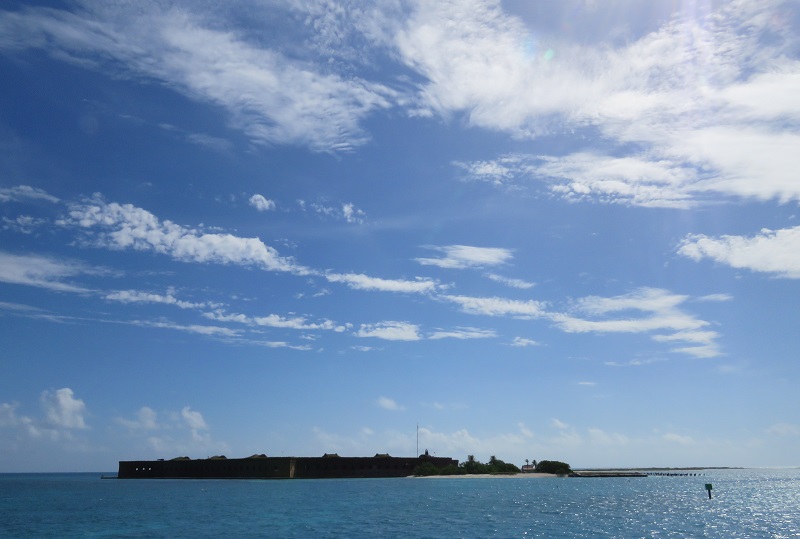
During the boat ride, we also learned that they offer tours of the fort. At 11 AM, they offer a 20 minute “tour” of the fort. It is really a short history of the importance of the islands and why the United States built one of their biggest forts in the middle of the Gulf of Mexico. At 11:30, they hold a longer 1.25 hour tour. The longer tour actually walks around the fort. We took the short tour and sat inside the fort at a group of benches while we listened to the guide. Each of the tours is limited to 25 people each but they promised to add another tour if there was sufficient demand. If you take the longer tour, they advise you to grab something for lunch between 11 and 11:30 AM so that you don’t miss lunch (which ends shortly after the tour, and they don’t want you to worry or go hungry!). It was recommended that you don’t do both tours (they overlap), so plan how you would prefer to spend your time.
The other thing that we learned during the boat ride was how to snorkel. They run a brief video that explains where to snorkel on the island, how to ensure that you have the right gear, putting on your equipment as well as how important it is not to touch the coral. You do not need to worry about bringing gear – the ferry provides snorkeling equipment for everyone that signs a waiver of liability. It is available starting at around 11 AM on the dock. For those that go to the beach, there is a salt water spray wash on the dock and a few fresh water open showers at the back of the boat. There are also changing rooms on the dock – there was a line for them around 2:15 PM. They request the snorkel equipment be returned by 2:30, about 15 minutes prior to the boat’s departure at 2:45pm.
After we arrived on Garden Key at 10:30am, we waited a few minutes for the boat to be docked and for the line to get onto the island. While we waited, we took pictures of the pelicans on the coaling docks and of the frigatebirds floating above the fort. You can see many of our bird photos here.
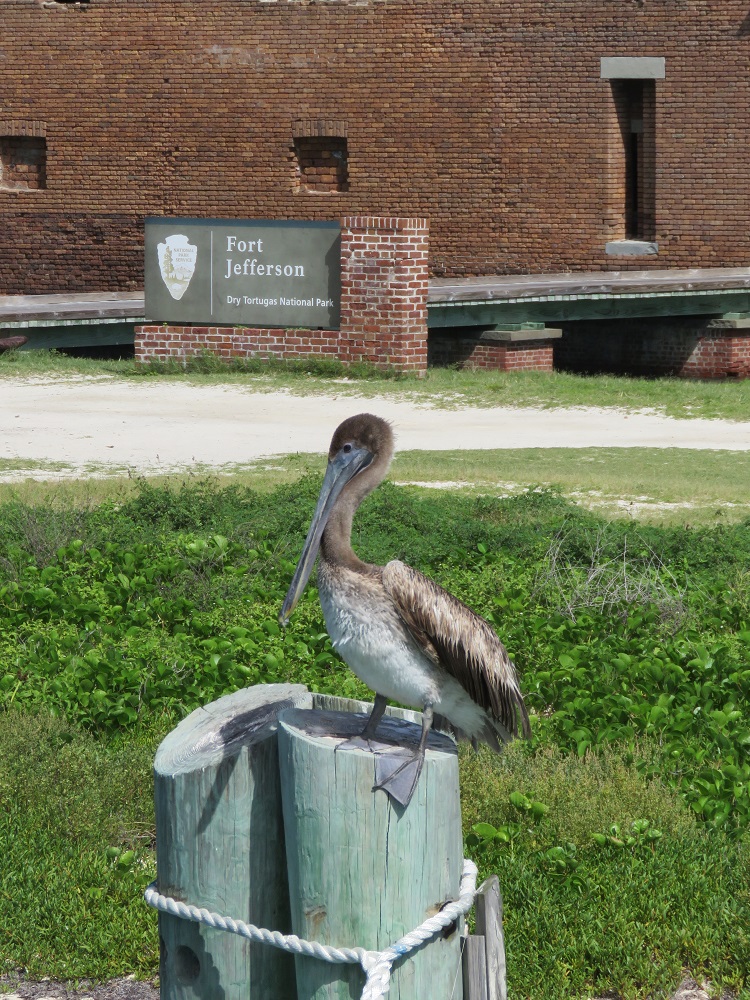
We took a few minutes to walk around the moat wall, which goes around all the sides of the fort, before arriving back at the front just in time for the 11am talk, led by “Hollywood,” an enthusiastic blond with a clear appreciation for the islands and a California surfer look appropriate for the nickname. He led us into the fort to a small theater near the visitor shop, where he led us to the most important question about the US’s largest, most fortified 1800s fort – why build it in the middle of the Gulf of Mexico?
The talk ended just on time, and Hollywood left to pick up the 11:30 tour. We ran into him again later as he led the group around, enthusiastically retelling stories from the history of the fort.
We returned to the boat for lunch, and were thankful for the Igloo dispenser of cold water on the dock. We also took a brief restroom break, as the only bathrooms on the island are on the Yankee Freedom (aside from a vault toilet available to campers when the boat is gone). Then we dove into the various lunch offerings – three kinds of bread ready for your choice of turkey, ham, tuna salad, cheeses, lettuce and tomatoes, sliced cucumbers, peppers and pickles, and fruit salad. There was also a selection of individually bagged chips, cans of Pepsi, bottles of water and a few other drink options.
After lunch, we went back to the table where we had left our things (there are no lockers on the island or the boat and they are proud to report no thefts!) and retrieved our National Park pass to get our passport stamp from the visitor’s center, just to the right of the sally-port (main door). The employee there explained how the Underground Railroad stamp came to be on the Dry Tortugas stamp stand (he didn’t really think it was significant, as several slaves had once attempted to escape but were captured and returned). We then started exploring the fort, starting out on the ground level and working our way up! Not only are there a number of cannons remaining, but you can see evidence of all the places the cannons once sat, working hard to protect the fort and the men inside and the ships docked in its harbors.
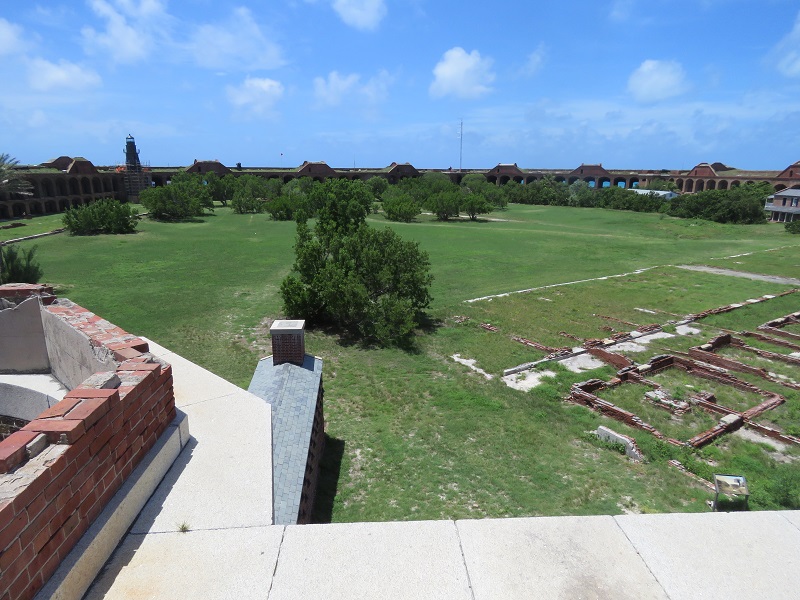
Fort Jefferson was a massive undertaking built over thirty years. Left unfinished, it was turned into a prison including famous individuals such as Dr. Samuel Mudd (the physician who famously treated President Lincoln’s assassin, John Wilkes Booth). There is a sign marking his prison cell on the middle floor, as well as discussing his time there.
The fort has stairs that allow you to reach the middle and top floor (roof). The top floor provides beautiful views of the interior of the fort as well as the surrounding island and seas. If you don’t walk to the roof and take a few pictures of the landscape and sea, then you are missing out! The fort is deteriorating – so be careful around the edges, open windows, and roof. We were warned that a fall could prove fatal since you are hours from a hospital. We ended up spending about an hour walking through the fort.
Since it was pretty hot and we only had a limited time left on the island, we headed back to the dock to pick up some snorkeling gear. They fitted us with masks and fins quickly and we headed over to the south beach area. We found a spot on the beach to drop our other stuff and got in the water to test out our gear. It took us a while to perfect the seal on the mask and breathing through the snorkel. Between the two of us, we only had one prior experience with snorkeling. I would definitely recommend buying a mask/snorkel and learning before your trip if you have never done it before. Since you only have a limited amount of time on the island, you don’t want to spend your time learning. Our snorkeling photos are here.
When you are going snorkeling, be sure to thoroughly apply sunscreen on your back and the back of your legs. We both got a little burned despite applying heavy suncreen to most areas and the short hour that they we were in the water.
After a brief test run along the beach area, and some doubt from me about whether I could actually do it, we headed off along the moat wall. This was the best part of our underwater experience. Although we didn’t see much brilliant coral, we got to see a lot of colorful fish and even found a school of 50-100 fish at one point. It was amazing to have them swim around us.
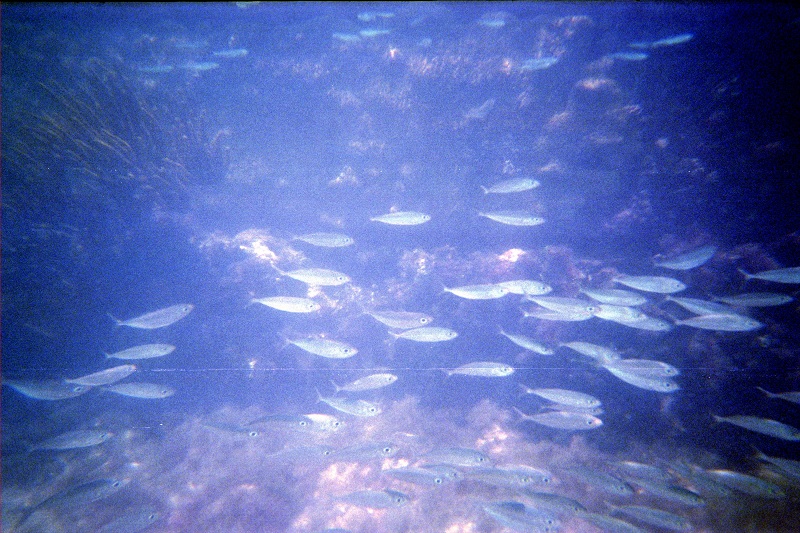
When it hit 2 PM, we started swimming back to the beach. It felt like it took forever to get back to the beach and reach shallow water, but it was in reality probably only 15 minutes. We took off our gear and exclaimed about how fun it was. We made the short walk back to the dock, dropped off our equipment, and showered in the fresh water on the boat to wash the sand off.
We stood in line at the changing rooms for a while to get out of our wet swimsuits and put on some dry clothes for the boat ride back.
At the end of the trip, when you aren’t going to return to the island, you check back in with the staff member at the end of the ramp leading to the boat. This allows them to keep track of whether they have everyone. Once we were on board, we grabbed two frozen alcoholic drinks. They are served on the boat after 2 PM and made the return boat trip much more enjoyable!
We arrived back at the dock just before 5:30 pm and walked a few blocks over to Duval Street to explore before our 7 pm dinner reservations. The sunset happened around 8:20 pm, so we ate at a leisurely pace and the sun set against the ocean as we started dinner. A wonderful end to a beautiful day.
